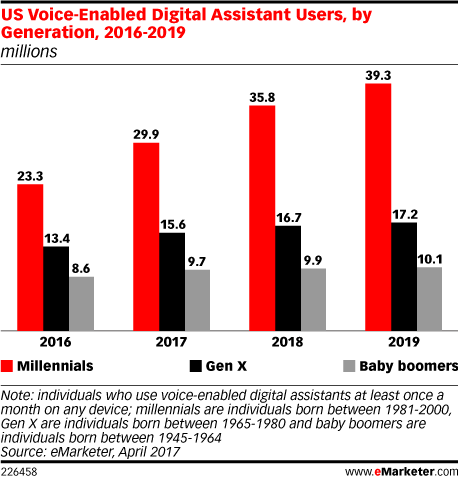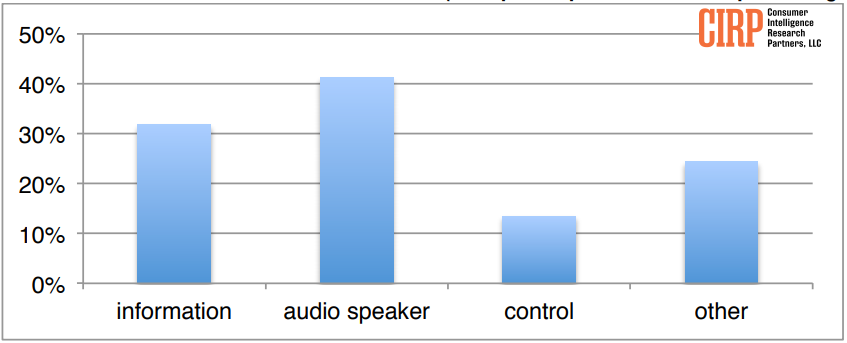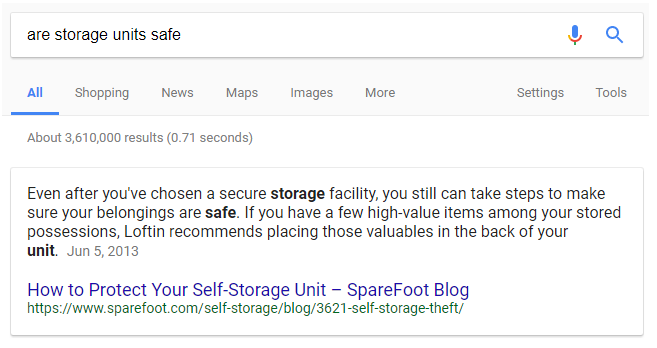The way your customers find information is changing
Search engines are a ubiquitous tool, integral to making our daily lives efficient. Before crawling out of bed, we can check the weather, place an Amazon order for our dog’s favorite treats, find directions to the morning’s professional development seminar, and schedule lunch to be delivered to our seminar attendees.
Equally as ubiquitous as search engines themselves is the input method—a keyboard and a screen. To many people, the search engine and the screen/keyboard peripherals are one-in-the-same. To use Google or Bing is to use a keyboard and a screen.
But imagine doing all of the aforementioned tasks not before getting out of bed but before opening your eyes.
This is the potential reality of voice-assisted search (voice search). But how will voice search impact businesses in the home service and self storage service industries such as self-storage?[note]For this POV, “home service and self storage service” is used to describe both traditional service business models by which businesses meet their customers on location (pest control, for example) as well as service business models that require businesses engage with customers on premise (self storage, for example). Excluded from this category are traditional retail business models (shopping malls and stand-alone retail, for example).[/note] How should home service and self storage service businesses adapt to voice search?
What is Voice Search?
Voice search is, simply put, the act of using spoken words, rather than text input, to use search engines and other search databases to find information online.
Common devices used for voice search include smartphones and home assistants (specific examples listed below). Devices use varying services—and therefore, varying search databases—to deliver search results.
| Device Company | Common Models |
| Google Home (home assistant), Android smartphones (Google is the default search engine) | |
| Amazon | Echo, Echo Plus, Echo Connect, Echo Dot |
| Microsoft | Various devices including Windows-based desktop computers and tablets, Microsoft smartphones (Bing is the default search engine) |
| Apple | iPhone (Google is the default search engine) |
Who is Using Voice Search?
“40% of adults now use voice search once per day” according to Location World
“50% of all searches will be voice searches by 2020” according to comscore
“About 30% of searches will be done without a screen by 2020.” via Mediapost
Millennials[note]Individuals born between 1981-2000[/note] are primarily responsible for the increase in voice search adoption since 2016. The trends is staggering enough that if adoption continues subsequent generations (Gen Z and Gen Alpha) will experience voice search not as a search proxy but as the search principal. In the same way that marketing agencies website developers have been stressing a “mobile first” approach to website design, a “voice first” approach will come to dominate strategy conversations in the coming years.
How Are People Currently Using Voice Search?
So far, the information presented here has been non-specific in terms of how people actually leverage voice search technology. While the percentages and data above are impressive, it’s important to remember that not all search queries are created equal.
According to a 2016 CIRP survey, Amazon Echo users aren’t often using voice search with transactional intent. Rather, queries tend to be informational and focused on controlling other devices (home appliances, audio speakers, etc). “Our research shows that more than half of Echo owners use the device as more than a voice-controlled music speaker,” noted Josh Lowitz, Partner and Co-Founder of CIRP. “Users report asking about weather and news, and increasingly controlling other connected devices.”
Current usage seems to fall into two categories that can be defined by their intent:
- Utility terms, meaning terms that have an immediate and very specific intent
- Non-Utility terms, meaning terms that imply a general need that connotes a degree of human interpretation and process
The Stone Temple survey found that 60% of voice search users want more answers and less search results. Utility vs non-utility.
Using voice search to ask about the weather or to play music by Tom Waits is very specific (utility). However, renting a storage unit or scheduling pest control service are, for now at least, restricted by a degree of interpretation and process (non-utility). As voice search evolves, it’s probable that these transactional hurdles will be surmounted. Currently, however, the screen-dependence associated with non-utility terms means screenless voice search user paths aren’t ideal for home service and self storage service transactions.
People often follow the path of least resistance, and until voice search allows a less resistant path for renting a storage unit or scheduling pest control services, screens or direct customer service interaction will continue to be important.
But that doesn’t mean such business types cannot still serve potential customers using voice search…
What can I do to serve customers using voice search?
Your customer hasn’t changed. Only the way they find you—and find information about you—has changed. While the transactional moment in a home service or self storage service customer journey may be hindered by voice search limitations, the opportunity to engage with potential customers prior to the transaction is very much present with voice search.
Go Local Interactive has always promoted a strong SEO strategy that abides by the following two guiding principles:
- Give users content they actually want and need
- Make a website (or app or any other indexable technology) easy for search engines to crawl and understand
The rise of voice search hasn’t changed #1. We still want to give users content they want and need. However, we have opportunity with #2. By adjusting the way we articulate the content on our website or app, we can provide content in a way that voice search technology can better understand.
First, it’s important to understand how home assistants and voice-search enabled devices arrive at the most relevant answer for a utility query. Using Google as an example, this most relevant answer can be seen visually, in the traditional screen-dependent context, as an Answer Box[note]Also referred to as the featured snippet, the quick answer, and rank zero.[/note] excerpt. This excerpt reflects content that Google has determined to be so relevant to your query that it deserves prominence.
These Answer Box results (along with Google Map Pack results) are what Google’s voice search enabled devices read aloud when a user conducts a voice search. Knowing this, we can now focus our strategy behind #2 above. Rather than chase the nebulous question “what do I need to do with voice search?” we can ask “how can I articulate my webpage content to appear in the Answer Box?”
How can I appear in the Google Answer Box?
Many of the best practices a strong SEO program has advocated for in the past will remain in effect when considering voice search strategies.
- Use structured markup
- Claim and optimize your business listings
- Answer questions directly
- Use lists
Use structured markup
Why use structured markup? Google says it best:
Google Search works hard to understand the content of a page. You can help us by providing explicit clues about the meaning of a page to Google by including structured data on the page. Structured data is a standardized format for providing information about a page and classifying the page content; for example, on a recipe page, what are the ingredients, the cooking time and temperature, the calories, and so on.
Claim and optimize your business listings
Major search listing platforms allow businesses to claim and optimize business listings to both ensure accuracy and to help users make purchasing decisions. Be sure to claim your business listings on Google Map Pack listing using Google My Business, as well as business listings on Yelp, Bing, and Apple Maps at a minimum.
It’s also important to reinforce the accuracy of your listing information by distributing accurate information across the internet using a listing distribution service.
Answer questions directly
Though Google and other search engines are getting better at understanding the content of webpages and app, you should strive to be as specific as possible when writing content for your users.
Don’t assume Google will know that your page about storage tips is a how-to page. Rather, specifically state the intent of the page using conversational language. “How to pack a storage unit” is better than “storage packing tips.”
The FAQ format itself hasn’t been shown to dominate Google Answer Box results. However, FAQ style content has. Answer Box results consistently include answers to very specific questions that adhere to the who, what, when, where, and how series of questions.
Use lists
Organize content using bulleted or numbered lists whenever possible. Lists are scannable and reflect an organized logic that users and search engines love.
How will voice impact organic media or paid media performance?
Will voice search disrupt the way we currently buy and analyze paid media and organic traffic? Yes, to a degree.
How will voice search impact paid media?
Broadly speaking, voice search could factor into lower cost-per-clicks and higher conversation rates, especially for Google AdWords buys. Google Home data, for example, contributes to the user profiles created by search behavior, which are one of the factors used to deliver ads. Simply put, Google knows more about you, so could target ads more effectively, which is a win for Google and a win for advertisers.
However, given the utility of voice search, and the one-answer result currently delivered by voice search devices, direct media buys on the voice search platforms aren’t yet commonplace. The adoption of voice search technologies is motivated in part by the trust users have in the results themselves. If the one-answer result becomes a paid placement (assuming the mechanisms of the paid placement is compromised by pay-to-win structures) then user trust erodes. This concept is why search engines generally take a stance against blending paid and organic results.
How will voice search impact organic media?
For now, we don’t anticipate any major changes in traffic activity, aside from any overall search engine usage trends. Google Home voice search is currently sans-screen, so non-utility results are audio only. For businesses that offer products and services that require research, that research will continue to be done with a screen available.
The biggest change in the organic space is likely how we will analyze and report on data. Currently voice search queries are indistinct from traditional text search queries in major analytics platforms like Google Analytics and Google Search Console. This is most certainly going to change. As voice search adoption grows, data analysts will demand visibility from these analytics platforms.
Final Thoughts
The lack of (currently existing) direct transactional opportunities shouldn’t dissuade home service and self storage service businesses from embracing the potential of voice search. Voice search offers an opportunity for businesses to build brand loyalty and trust by positioning themselves as de facto resources for common consumer questions.
At the moment when users are ready to become customers—when they are ready to transact—voice search plays a role in making that connection. Voice search can find a relevant nearby business, but the means by which voice search accomplishes this should already be part of your online marketing strategy—claiming and optimizing business listings, including structured markup on your website location pages, and providing relevant content to users.
Voice search will undoubtedly change the way people find you. As voice search evolves and matures, it may even change the way people transact with you. Until that happens, maintain a focus on providing your potential customers with quality content, but put an extra focus on ensuring that content is articulated for voice search technologies.






